JET 690214, 691208, 691205, 690150, 690151 User Manual
...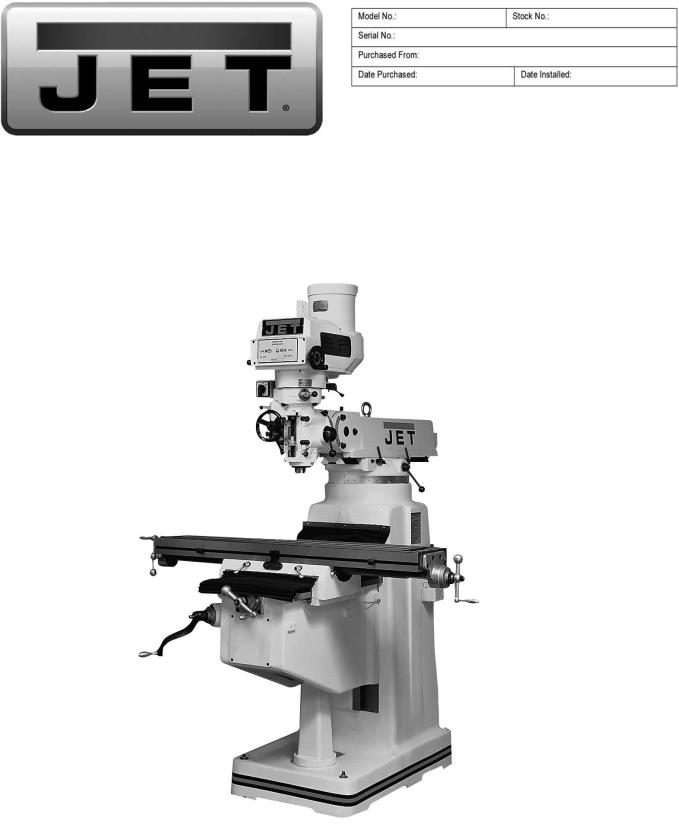
Operating Instructions and Parts Manual
Variable Speed Turret Mill
Model JTM-1050
JET |
|
427 New Sanford Road |
Part No. M-690050 |
LaVergne, Tennessee 37086 |
|
Ph.: 800-274-6848 |
Revision G 07/2014 |
www.jettools.com |
Copyright © 2014 JET |

1.0 Warranty and Service
JET® warrants every product it sells against manufacturers’ defects. If one of our tools needs service or repair, please contact Technical Service by calling 1-800-274-6846, 8AM to 5PM CST, Monday through Friday.
Warranty Period
The general warranty lasts for the time period specified in the literature included with your product or on the official JET branded website.
•JET products carry a limited warranty which varies in duration based upon the product. (See chart below)
•Accessories carry a limited warranty of one year from the date of receipt.
•Consumable items are defined as expendable parts or accessories expected to become inoperable within a reasonable amount of use and are covered by a 90 day limited warranty against manufacturer’s defects.
Who is Covered
This warranty covers only the initial purchaser of the product from the date of delivery.
What is Covered
This warranty covers any defects in workmanship or materials subject to the limitations stated below. This warranty does not cover failures due directly or indirectly to misuse, abuse, negligence or accidents, normal wear-and-tear, improper repair, alterations or lack of maintenance. JET woodworking machinery is designed to be used with Wood. Use of these machines in the processing of metal, plastics, or other materials may void the warranty. The exceptions are acrylics and other natural items that are made specifically for wood turning.
Warranty Limitations
Woodworking products with a Five Year Warranty that are used for commercial or industrial purposes default to a Two Year Warranty. Please contact Technical Service at 1-800-274-6846 for further clarification.
How to Get Technical Support
Please contact Technical Service by calling 1-800-274-6846. Please note that you will be asked to provide proof of initial purchase when calling. If a product requires further inspection, the Technical Service representative will explain and assist with any additional action needed. JET has Authorized Service Centers located throughout the United States. For the name of an Authorized Service Center in your area call 1-800-274-6846 or use the Service Center Locator on the JET website.
More Information
JET is constantly adding new products. For complete, up-to-date product information, check with your local distributor or visit the JET website.
How State Law Applies
This warranty gives you specific legal rights, subject to applicable state law.
Limitations on This Warranty
JET LIMITS ALL IMPLIED WARRANTIES TO THE PERIOD OF THE LIMITED WARRANTY FOR EACH PRODUCT. EXCEPT AS STATED HEREIN, ANY IMPLIED WARRANTIES OF MERCHANTABILITY AND FITNESS FOR A PARTICULAR PURPOSE ARE EXCLUDED. SOME STATES DO NOT ALLOW LIMITATIONS ON HOW LONG AN IMPLIED WARRANTY LASTS, SO THE ABOVE LIMITATION MAY NOT APPLY TO YOU.
JET SHALL IN NO EVENT BE LIABLE FOR DEATH, INJURIES TO PERSONS OR PROPERTY, OR FOR INCIDENTAL, CONTINGENT, SPECIAL, OR CONSEQUENTIAL DAMAGES ARISING FROM THE USE OF OUR PRODUCTS. SOME STATES DO NOT ALLOW THE EXCLUSION OR LIMITATION OF INCIDENTAL OR CONSEQUENTIAL DAMAGES, SO THE ABOVE LIMITATION OR EXCLUSION MAY NOT APPLY TO YOU.
JET sells through distributors only. The specifications listed in JET printed materials and on official JET website are given as general information and are not binding. JET reserves the right to effect at any time, without prior notice, those alterations to parts, fittings, and accessory equipment which they may deem necessary for any reason whatsoever. JET® branded products are not sold in Canada by JPW Industries, Inc.
Product Listing with Warranty Period
90 Days – Parts; Consumable items; Light-Duty Air Tools
1 Year – Motors; Machine Accessories; Heavy-Duty Air Tools; Pro-Duty Air Tools
2 Year – Metalworking Machinery; Electric Hoists, Electric Hoist Accessories; Woodworking Machinery used for industrial or commercial purposes
5 Year – Woodworking Machinery
Limited Lifetime – JET Parallel clamps; VOLT Series Electric Hoists; Manual Hoists; Manual Hoist Accessories; Shop Tools; Warehouse & Dock products; Hand Tools
NOTE: JET is a division of JPW Industries, Inc. References in this document to JET also apply to JPW Industries, Inc., or any of its successors in interest to the JET brand.
2
2.0 |
Table of contents |
|
|
Section |
Page |
||
1.0 Warranty and Service..................................................................................................................................... |
2 |
||
2.0 |
Table of contents............................................................................................................................................ |
3 |
|
3.0 |
Safety warnings.............................................................................................................................................. |
4 |
|
4.0 |
About this manual .......................................................................................................................................... |
5 |
|
5.0 |
Specifications ................................................................................................................................................. |
6 |
|
6.0 |
JTM-1050 Installation Layout ......................................................................................................................... |
7 |
|
7.0 JTM-1050 Features and Terminology ............................................................................................................ |
8 |
||
8.0 Setup and Assembly ...................................................................................................................................... |
9 |
||
8.1 Unpacking .................................................................................................................................................. |
9 |
||
8.2 |
Contents of shipping container................................................................................................................... |
9 |
|
8.3 |
Site preparation ........................................................................................................................................ |
10 |
|
8.4 |
Lifting the mill ........................................................................................................................................... |
10 |
|
8.5 Completing assembly ............................................................................................................................... |
10 |
||
8.6 |
Lubrication................................................................................................................................................ |
11 |
|
9.0 |
Electrical Connections.................................................................................................................................. |
11 |
|
9.1 Wire Sizes ................................................................................................................................................ |
11 |
||
10.0 |
Operating controls...................................................................................................................................... |
12 |
|
11.0 |
Operating precautions................................................................................................................................ |
13 |
|
12.0 Adjustments ............................................................................................................................................... |
13 |
||
12.1 |
Drawbar operation - changing tooling .................................................................................................... |
13 |
|
12.2 |
Clamping workpiece to table .................................................................................................................. |
13 |
|
12.3 |
Changing speed range ........................................................................................................................... |
14 |
|
12.4 |
Manual feed............................................................................................................................................ |
14 |
|
12.5 |
Automatic feed ....................................................................................................................................... |
14 |
|
12.6 |
Mill head – left/right movement .............................................................................................................. |
15 |
|
12.7 |
Mill head – angle setting......................................................................................................................... |
16 |
|
12.8 |
Ram movement ...................................................................................................................................... |
16 |
|
12.9 |
Table Movement..................................................................................................................................... |
16 |
|
12.10 Feed Trip Adjustment ........................................................................................................................... |
17 |
||
13.0 Maintenance............................................................................................................................................... |
17 |
||
13.1 |
General maintenance ............................................................................................................................. |
17 |
|
13.2 |
Lubrication.............................................................................................................................................. |
17 |
|
13.3 |
Gib adjustment ....................................................................................................................................... |
18 |
|
13.4 |
Motor removal ........................................................................................................................................ |
18 |
|
13.5 |
Timing belt replacement ......................................................................................................................... |
18 |
|
13.6 |
Drive belt replacement ........................................................................................................................... |
19 |
|
13.7 |
Brake shoe replacement ........................................................................................................................ |
19 |
|
13.8 |
Leadscrew backlash adjustment ............................................................................................................ |
19 |
|
14.0 Replacement Parts..................................................................................................................................... |
21 |
||
14.1.1 JTM-1050 Variable Speed Head Assembly – Exploded View............................................................. |
22 |
||
14.1.2 JTM-1050 Variable Speed Head Assembly – Parts List ..................................................................... |
23 |
||
14.2.1 JTM-1050 Head Assembly – Exploded View ...................................................................................... |
25 |
||
14.2.2 JTM-1050 Head Assembly – Parts List ............................................................................................... |
26 |
||
14.3.1 JTM-1050 Base Assembly – Exploded View....................................................................................... |
29 |
||
14.3.2 JTM-1050 Base Assembly – Parts List ............................................................................................... |
30 |
||
14.4.1 JTM-1050 Table Leadscrew Assembly – Exploded View ................................................................... |
32 |
||
14.4.2 JTM-1050 Table Leadscrew Assembly – Parts List ............................................................................ |
33 |
||
14.5.1 JTM-1050 One-Shot Lubrication System – Exploded View ................................................................ |
34 |
||
14.5.2 JTM-1050 One-Shot Lubrication System – Parts List ......................................................................... |
34 |
||
15.0 |
Electrical Connections for JTM-1050 ......................................................................................................... |
35 |
|
3

3.0 Safety warnings
1.Read and understand the entire owner's manual before attempting assembly or operation.
2.Read and understand the warnings posted on the machine and in this manual. Failure to comply with all of these warnings may cause serious injury.
3.Replace the warning labels if they become obscured or removed.
4.This machine is designed and intended for use by properly trained and experienced personnel only. If you are not familiar with the proper and safe operation of milling machines, do not use until proper training and knowledge have been obtained.
5.Do not use this milling machine for other than its intended use. If used for other purposes, JET disclaims any real or implied warranty and holds itself harmless from any injury that may result from that use.
6.Always wear approved safety glasses/face shields while using this machine. Everyday eyeglasses only have impact resistant lenses; they are not safety glasses.
7.Before operating this machine, remove tie, rings, watches and other jewelry, and roll sleeves up past the elbows. Remove all loose clothing and confine long hair. Non-slip footwear or anti-skid floor strips are recommended. Do not wear gloves.
8.Wear ear protectors (plugs or muffs) during extended periods of operation.
9.Some dust created by power sanding, sawing, grinding, drilling and other construction activities contain chemicals known to cause cancer, birth defects or other reproductive harm. Some examples of these chemicals are:
•Lead from lead based paint.
•Crystalline silica from bricks, cement and other masonry products.
•Arsenic and chromium from chemically treated lumber.
Your risk of exposure varies, depending on how often you do this type of work. To reduce your exposure to these chemicals, work in a well-ventilated area and work with approved safety equipment, such as face or dust masks that are specifically designed to filter out microscopic particles.
10.Do not operate this machine while tired or under the influence of drugs, alcohol or any medication.
11.Make certain the switch is in the OFF position before connecting the machine to the power supply.
12.Make certain the machine is properly grounded.
13.Make all machine adjustments or maintenance with the machine unplugged from the power source.
14.Remove adjusting keys and wrenches. Form a habit of checking to see that keys and adjusting wrenches are removed from the machine before turning it on.
15.Keep safety guards in place at all times when the machine is in use. If removed for maintenance purposes, use extreme caution and replace the guards immediately after completion of maintenance.
16.Keep hands away from all moving parts (belts, cutters, gears, etc.)
17.Check damaged parts. Before further use of the machine, a guard or other part that is damaged should be carefully checked to determine that it will operate properly and perform its intended function. Check for alignment of moving parts, binding of moving parts, breakage of parts, mounting and any other conditions that may affect its operation. A guard or other part that is damaged should be properly repaired or replaced.
18.Provide for adequate space surrounding work area and non-glare, overhead lighting.
19.Keep the floor around the machine clean and free of scrap material, oil and grease.
20.Some coolants used for machining contain chemicals that may be hazardous to your health if not use properly. Read and understand all user information listed on the coolant container and protect yourself accordingly.
21.Keep visitors a safe distance from the work area. Keep children away.
22.Make your workshop child proof with padlocks, master switches or by removing starter keys.
23.Give your work undivided attention. Looking around, carrying on a conversation and “horseplay” are careless acts that can result in serious injury.
24.Maintain a balanced stance at all times so that you do not fall into the blade or other moving parts. Do not overreach or use excessive force to perform any machine operation.
4
25.Use the right tool at the correct speed and feed rate. Rotate spindle clockwise for righthand tools, counterclockwise for left-hand tools. Do not force a tool or attachment to do a job for which it was not designed. The right tool will do the job better and more safely.
26.Use recommended accessories; improper accessories may be hazardous.
27.Frequently clean this machine. Maintain tools with care. Keep cutters sharp and clean for the best and safest performance. Follow instructions for lubricating and changing accessories.
28.Turn off the machine before cleaning. Use a brush to remove chips or debris — do not use your hands.
29.Do not stand on the machine. Serious injury could occur if the machine tips over.
30.Never leave the machine running unattended. Turn the power off and do not leave the machine until it comes to a complete stop.
31.Remove loose items and unnecessary work pieces from the area before starting the machine.
32.Don’t use in dangerous environment. Don’t use power tools in damp or wet location, or expose them to rain. Keep work area well lighted.
33.Some coolants used for machining contain chemicals that may be hazardous to your health if not used properly. Read and understand all user information listed on the coolant container and protect yourself accordingly.
Familiarize yourself with the following safety notices used in this manual:
 This means that if precautions are not heeded, it may result in minor injury and/or possible machine damage.
This means that if precautions are not heeded, it may result in minor injury and/or possible machine damage.
 This means that if precautions are not heeded, it may result in serious, or possibly even fatal, injury.
This means that if precautions are not heeded, it may result in serious, or possibly even fatal, injury.
4.0 About this manual
This manual is provided by JET covering the safe operation and maintenance procedures for a JET Model JTM-1050 Turret Mill. This manual contains instructions on installation, safety precautions, general operating procedures, maintenance instructions and parts breakdown. Your machine has been designed and constructed to provide years of trouble-free operation if used in accordance with the instructions as set forth in this document.
This manual is intended to familiarize you with the technical aspects of this milling machine. It is not, nor was it intended to be, a training manual. Do not operate this machine until appropriate training and knowledge have been acquired.
If there are questions or comments, please contact your local supplier or JET. JET can also be reached at our web site: www.jettools.com.
Retain this manual for future reference. If the machine transfers ownership, the manual should accompany it.
 Read and understand the entire contents of this manual before attempting assembly or operation! Failure to comply may cause serious injury!
Read and understand the entire contents of this manual before attempting assembly or operation! Failure to comply may cause serious injury!
5
5.0 Specifications |
|
Model Number......................................................................................................................................... |
JTM-1050 |
Stock Number ............................................................................................................................................. |
690050 |
Motor and Electricals: |
|
Motor type ...................................................................................................................................................... |
TEFC |
Horsepower....................................................................................................................................... |
3 HP (2.2 kW) |
Phase .................................................................................................................................................................... |
3 |
Voltage .......................................................................................................................... |
230/460V (prewired 230V) |
Cycle ............................................................................................................................................................... |
60Hz |
Listed FLA (full load amps) .......................................................................................................................... |
8.2/4.1 |
Motor Speed (RPM) ........................................................................................................................................ |
1720 |
Power transfer................................................................................................................................................... |
belt |
Sound Emission (tested at 3 ft. from machine): |
|
Without load .............................................................................................................................................. |
75 dB |
With load ............................................................................................................................................. |
80-85 dB |
Head and Spindle: |
|
Spindle Taper.................................................................................................................................................... |
R-8 |
Diameter of Quill (in.) ...................................................................................................................................... |
3-3/8 |
Number of Spindle Speeds ........................................................................................................................ |
Variable |
Range of Spindle Speeds (RPM) ........................................................................................................... |
70 to 3800 |
Downfeeds per Revolution of Spindle (in.)............................................................................ |
0.0015, 0.003, 0.006 |
Spindle Travel (in.) ................................................................................................................................................ |
5 |
Head Movement – Left and Right (deg.) ............................................................................................................. |
90 |
Head Movement – Fore and Aft (deg.)................................................................................................................ |
45 |
Maximum Distance Spindle Nose to Table (in.) .................................................................................................. |
19 |
Maximum Distance Spindle Center to Column (in.) ...................................................................................... |
26-1/2 |
Minimum Distance Spindle Center to Column (in.) ......................................................................................... |
5-1/2 |
Collet Capacity (in.)................................................................................................................................... |
1/8 – 7/8 |
Ram Travel, maximum (in.)........................................................................................................................... |
20-1/2 |
Table: |
|
Table Size (in.) ............................................................................................................................................ |
10 x 50 |
Longitudinal Table Travel, maximum (in.) ........................................................................................................... |
30 |
Table Cross Travel, maximum (in.) ............................................................................................................... |
15-1/4 |
Number of T-Slots ................................................................................................................................................. |
3 |
T-Slot Size, width (in.) ........................................................................................................................................ |
5/8 |
T-Slot Centers (in.).......................................................................................................................................... |
2-1/2 |
Table Load, maximum (lbs.).............................................................................................................................. |
720 |
Knee Travel, maximum (in.) .......................................................................................................................... |
14-1/4 |
Dimensions: |
|
Overall Dimensions, assembled (in.) .......................................................................... |
96-1/2 W x 77 D x 87-3/4 H |
Weights: |
|
Net Weight, approx. (lbs.) ............................................................................................................................... |
2751 |
Shipping Weight, approx.. (lbs.) ...................................................................................................................... |
2900 |
The specifications in this manual were current at time of publication, but because of our policy of continuous improvement, JET reserves the right to change specifications at any time and without prior notice, without incurring obligations.
6
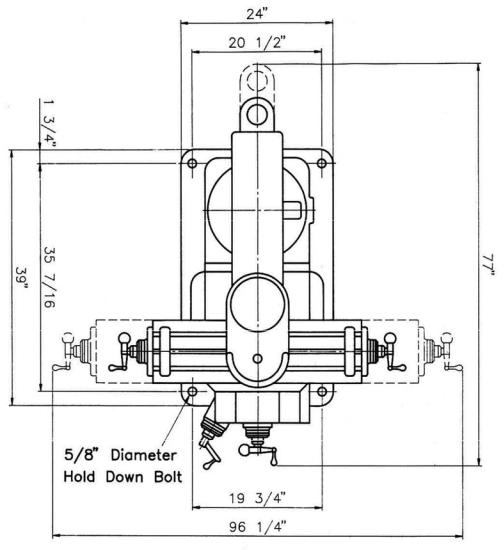
6.0 JTM-1050 Installation Layout
Figure 1
7
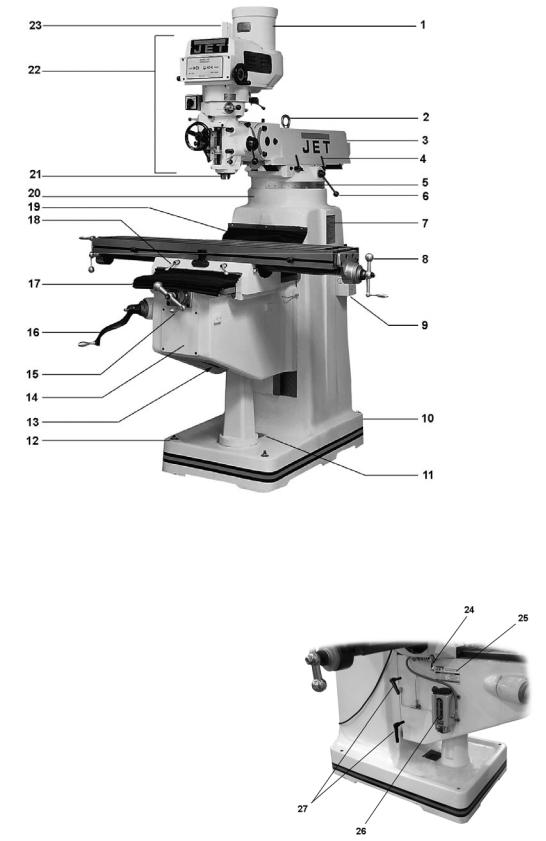
7.0 JTM-1050 Features and Terminology
|
Figure 2: Features and Terminology |
||
1. |
3HP Motor |
23. |
Motor junction box |
2. |
Lifting ring |
24. |
Saddle locking handle |
3. |
Ram |
25. |
Lubrication chart |
4. |
Ram locking handle (x2) |
26. |
One-shot lube system |
5. |
Turret scale |
27. |
Knee locking handle (x2) |
6. |
Ram movement lever |
|
|
7. |
I.D./Warning Label |
|
|
8. |
Table longitudinal crank handle (x2) |
|
|
9. |
Power connection box |
|
|
10. |
Base |
|
|
11. |
Strainer (for use with optional flood coolant |
|
|
|
systems) |
|
|
12. |
Holes for mounting bolts (x4) |
|
|
13. |
Elevating leadscrew |
|
|
14. |
Knee |
|
|
15. |
Crossfeed handle |
|
|
16. |
Knee crank handle |
|
|
17. |
Pleated way cover |
|
|
18. |
Table locking handle (x2) |
|
|
19. |
Flat way cover |
|
|
20. |
Column |
|
|
21. |
Spindle |
|
Figure 2a |
22. |
Head assembly (see section 10.0 for explanation of |
|
|
controls)
8
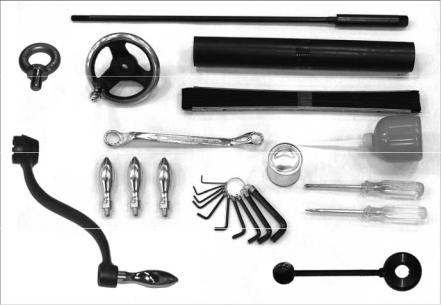
8.0Setup and Assembly
8.1Unpacking
Open shipping container and check for shipping damage. Report any damage immediately to your distributor and shipping agent. Do not discard any shipping material until the Turret Mill is assembled and running properly.
Compare the contents of your container with the following parts list to make sure all parts are intact. Missing parts, if any, should be reported to your distributor. Note: Check the mill first – some parts may have been pre-installed on the mill.
Read the instruction manual thoroughly for assembly, maintenance and safety instructions.
8.2 Contents of shipping container
Refer to Figure 3:
1 Turret Mill (not shown)
1 Flat Way Cover
1 Pleated Way Cover
1 Draw Bar
3 Table Adjustment Handles
1Tool Box, containing:
1 Hex Key Set (1.5-10mm) *
1 17/19mm Box Wrench *
1 Cross Point Screw Driver #2 *
1 Flat Blade Screw Driver #2 *
1 Plastic Oil Bottle *
1 |
Elevating Crank Handle |
1 |
Handwheel |
1 |
Coarse Feed Handle |
1 |
Can White Touch Up Paint |
1 |
Lifting Ring |
1 |
Operator’s Manual (not shown) |
1 |
Warranty Card (not shown) |
* parts with an asterisk are also included in the tool box service kit, p/n JTM4VS-TB.
Figure 3: Shipping contents
 Read and understand the entire contents of this manual before attempting set-up or operation! Failure to comply may cause serious injury.
Read and understand the entire contents of this manual before attempting set-up or operation! Failure to comply may cause serious injury.
NOTE
If your mill is supplied with an optional Table Powerfeed and/or DRO, be sure to consult the separate instruction materials that accompany them.
9
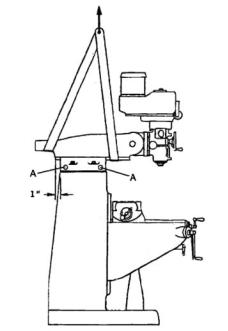
8.3 Site preparation
The mill must be placed on an even surface and bolted to the floor. Anchor bolts of sufficient size and length must be fastened to the floor according to the mill’s footprint. See the site installation diagram in Figure 1.
When spotting the machine be certain to leave room not only for the machine itself, but also for operator clearance and clearance for workers servicing the machine, and any unusual sizes of workpieces that might extend off the machine’s table.
8.4 Lifting the mill
Finish removing the sides of the crate. Leave mill bolted to pallet until ready to move to its final location.
The preferred method for lifting mill is with a hook through the lifting ring screwed into the tapped hole atop the ram. Steady the mill to prevent it from spinning.
Check the lifting ring on the ram to be certain it is tight.
Check the tightness of the lock handles on the ram (A, Figure 4) to be certain the ram is tightly locked.
An alternative method for lifting the mill is with a sling. Follow diagram in Figure 4 for proper position of sling under ram. Note position of ram and that table has been moved against column. Tighten ram locking bolts (A, Figure 4) before lifting.
Figure 4: sling location
1.Remove the nuts and/or bolts, which secure the machine to the pallet.
2.Center an overhead crane or other suitable overhead lifting device and sling arrangement over the lifting ring.
Note: This machine weighs over 2800 pounds. Be certain the lifting arrangement is new or in excellent condition and has a safety factor that will account for age, difficulties in lifting, etc. When lifting using the ring, the machine may tend to tip forward. If you wish, you can minimize this tipping by rigging a support sling over the front of the machine. Be careful when doing this, to prevent the sling from damaging any components on the front of the machine. Be sure to steady the mill to prevent it from spinning.
3.Lift the machine off the pallet no higher than necessary to clear the hold-down hardware, then pull the pallet out of the way. Do NOT get hands or feet underneath the machine when removing the pallet.
4.Lower the mill over the anchor bolts. Level the machine using shims under the corners needing them. The machinist’s level used for leveling should be placed on the table. The table is the reference surface for both side-to- side and fore-and-aft leveling. Be certain you get it level in BOTH directions.
 Mill must be supported equally under all four corners. Failure to comply may cause the column to twist and put a bind in the table ways.
Mill must be supported equally under all four corners. Failure to comply may cause the column to twist and put a bind in the table ways.
5.When the machine is level, secure the base to the anchoring system.
8.5 Completing assembly
 Before attempting to raise mill head, familiarize yourself with instructions in section 12.5, for procedures to safely raise and set up the mill head.
Before attempting to raise mill head, familiarize yourself with instructions in section 12.5, for procedures to safely raise and set up the mill head.
1.Loosen the four hexagonal nuts (see A, Figure
9) about one-quarter (1/4) turn each counterclockwise, just enough to allow rotation of the head.
2.Apply upward pressure on motor by hand to relieve pressure on worm mechanism, and use supplied wrench to turn worm nut (B, Figure 8) and raise head to upright position.
3.Tighten nuts (A, Figure 9); not torqued at this time, just snug. Before operating mill, follow procedures in section 12.5 to verify angle settings and properly tighten the four nuts.
4.Using mineral spirits or other cleaning solvent, clean all of the rust proofing from where it may have been applied. This is important; moving the table or any other components before removing the rust proofing will only put rust proofing where you don’t want it. (Do not use
10
gasoline, paint thinner, or lacquer thinner. These will damage painted surfaces.)
5.Lubricate exposed ways, then move each unit (table and ram) to the opposite limit stop, and clean and lubricate the newly exposed ways. Loosen bolts to unlock ram and move it forward and backward to the full length in order to clean and lubricate.
6.Cover all machined surfaces with a film of light machine tool oil to inhibit rust.
Some of the following steps may have already been performed on the machine. If so, ignore the instructions related to those particular steps. Otherwise, perform them in the order listed. Refer to Figures 2 and 5 to help locate items.
1.Install the table longitudinal and cross-feed crank handles on their respective shafts using the nuts on the shafts to secure them.
2.Remove any rust proofing from the drawbar and its washer, and put the drawbar with washer installed into the spindle center through the top of the machine.
3.Slide the fine feed handwheel over the handwheel hub and push it back until its roll pin engages the hole in the hub and the wheel is flush with the hub surface.
4.Put the coarse feed handle on the feed shaft and tap it lightly until its roll pin engages a hole in the hub and it is flush against the hub surface.
5.Unwrap and clean the elevating (knee) crank and install it on its shaft.
6.Install the rubber way covers at front and behind the table.
8.6 Lubrication
 Do not operate the mill before lubricating the machine fully. Failure to comply may cause damage to the machine.
Do not operate the mill before lubricating the machine fully. Failure to comply may cause damage to the machine.
Before operating mill, refer to sect. 13.2 for lubricating instructions.
9.0 Electrical Connections
 All electrical connections must be made by a qualified electrician. Failure to comply may cause serious or fatal injury.
All electrical connections must be made by a qualified electrician. Failure to comply may cause serious or fatal injury.
The JTM-1050 mill is rated at 230/460V, 3-phase and comes from the factory prewired at 230V.
Confirm power at the site matches power requirements of the mill before connecting to the power source. The power source should be dedicated to the JTM-1050 mill. The main power switch is located on the right side of the machine.
Remove the cover, and run the main power cable through the box and attach the ground, followed by power leads. Replace the cover.
Check for proper spindle rotation in the high speed range. The spindle should rotate clockwise when viewed from the top of the machine. If the spindle rotates counterclockwise, disconnect from the power source, and switch two of the power leads.
To change from 230V to 460V operation, remove the junction box cover on the motor, and change the wires according to the diagram found on the inside of the cover. A similar wiring diagram is found at the back of this manual. Note: If discrepancies arise, diagrams on machine take precedence.
The mill must be properly grounded.
9.1 Wire Sizes
 For circuits which are far away from the electrical service box, the wire size must be increased in order to deliver ample voltage to the motor. To minimize power losses and to prevent motor overheating and burnout, the use of wire sizes for branch circuits or electrical extension cords according to the following table is recommended:
For circuits which are far away from the electrical service box, the wire size must be increased in order to deliver ample voltage to the motor. To minimize power losses and to prevent motor overheating and burnout, the use of wire sizes for branch circuits or electrical extension cords according to the following table is recommended:
Conductor |
AWG Number |
Length |
230/460 Volt Lines |
0 – 50 Ft. |
No. 14 |
50 – 100 Ft. |
No. 14 |
Over 100 Ft. |
No. 12 |
|
Table 1 |
11
